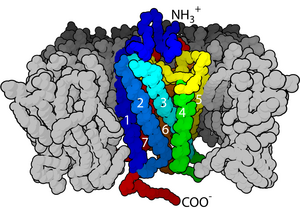
A neurotransmitter receptor (also known as a neuroreceptor) is a membrane receptor protein[1] that is activated by a neurotransmitter.[2] Chemicals on the outside of the cell, such as a neurotransmitter, can bump into the cell's membrane, in which there are receptors. If a neurotransmitter bumps into its corresponding receptor, they will bind and can trigger other events to occur inside the cell. Therefore, a membrane receptor is part of the molecular machinery that allows cells to communicate with one another. A neurotransmitter receptor is a class of receptors that specifically binds with neurotransmitters as opposed to other molecules.
In postsynaptic cells, neurotransmitter receptors receive signals that trigger an electrical signal, by regulating the activity of ion channels. The influx of ions through ion channels opened due to the binding of neurotransmitters to specific receptors can change the membrane potential of a neuron. This can result in a signal that runs along the axon (see action potential) and is passed along at a synapse to another neuron and possibly on to a neural network.[1] On presynaptic cells, there are receptors known as autoreceptors that are specific to the neurotransmitters released by that cell, which provide feedback and mediate excessive neurotransmitter release from it.[3]
There are two major types of neurotransmitter receptors: ionotropic and metabotropic. Ionotropic means that ions can pass through the receptor, whereas metabotropic means that a second messenger inside the cell relays the message (i.e. metabotropic receptors do not have channels). There are several kinds of metabotropic receptors, including G protein-coupled receptors.[2][4] Ionotropic receptors are also called ligand-gated ion channels and they can be activated by neurotransmitters (ligands) like glutamate and GABA, which then allow specific ions through the membrane. Sodium ions (that are, for example, allowed passage by the glutamate receptor) excite the post-synaptic cell, while chloride ions (that are, for example, allowed passage by the GABA receptor) inhibit the post-synaptic cell. Inhibition reduces the chance that an action potential will occur, while excitation increases the chance. Conversely, G-protein-coupled receptors are neither excitatory nor inhibitory. Rather, they can have a broad number of functions such as modulating the actions of excitatory and inhibitory ion channels or triggering a signalling cascade that releases calcium from stores inside the cell.[2] Most neurotransmitters receptors are G-protein coupled.[1]
- ^ a b c Levitan, Irwin B.; Leonard K. Kaczmarek (2002). The Neuron (Third pg. 285 ed.). Oxford University Press.
- ^ a b c "Neurological Control - Neurotransmitters". Brain Explorer. 2011-12-20. Retrieved 2012-11-04.
- ^ "Neurotransmitter Receptors, Transporters, & Ion Channels". www.rndsystems.com.
- ^ "3. Neurotransmitter Postsynaptic Receptors". Web.williams.edu. Retrieved 2012-11-04.